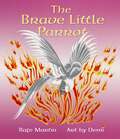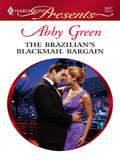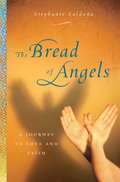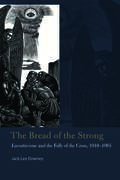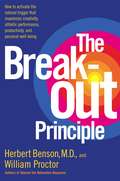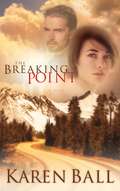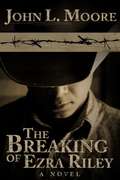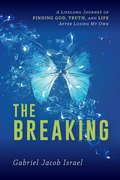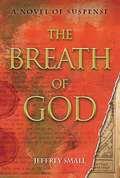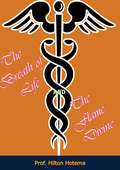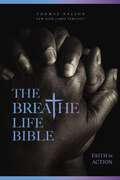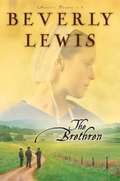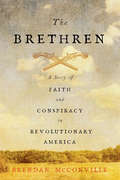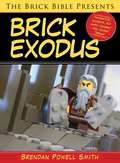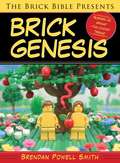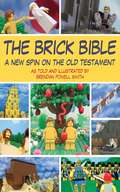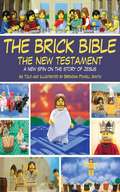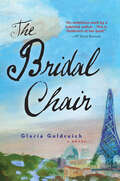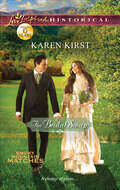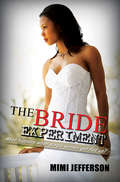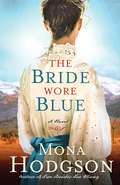- Table View
- List View
The Brave Little Parrot
by Rafe MartinHow can you save a burning forest with just sprinkles of water? This timeless Buddhist tale may just have the answer!In this ancient tale of one of the Buddha&’s past lives, the Buddha is born as a little gray parrot who takes it upon herself to save her beloved forest home from a raging fire. Even though she can only sprinkle drops of water onto the blaze, her perseverance, courage, and compassion change everything, eventually saving the forest in an unexpected way. Zen teacher and acclaimed storyteller Rafe Martin and award-winning illustrator Demi render this centuries-old classic into a beautiful and timeless tale that will inspire all of us to find our own bravery and to act selflessly for the benefit of all.
The Brazilian's Blackmail Bargain (Bedded by Blackmail #7)
by Abby GreenSix months ago Brazilian tycoonCaleb Cameron thought he'd uncoveredMaggie Holland's plot to ruin him-usingseduction! But Maggie was being manipulatedby her stepfather. She'd fallen in love withCaleb-but he vowed never to see her again.After her stepfather dies, Maggie is left withnothing. Now, to complete his revenge, Calebmakes an offer Maggie can't refuse: but shemust become his mistress for two months!
The Brazos Introduction to Christian Spirituality
by Evan B. HowardEvan Howard provides a solid and comprehensive overview of spiritual formation in the Protestant, Catholic, and Eastern Orthodox traditions in The Brazos Introduction to Christian Spirituality. In short, Howard desires to answer the following question for readers: "What does relationship with God look like for Christians?" The book is interdisciplinary in its approach, drawing from fields such as theology and psychology. What makes this book especially accessible are its chapter outlines and objectives, sidebars, focus boxes, charts, pictures, cartoons, chapter summaries and questions, and glossary, all of which present the material in an easily digestible format for the curious layperson.
The Bread and the Wine: The Story of the Last Supper
by Denise AhernThis book is a child's version of the Last Supper. It is replete with illustrations to make the story more enjoyable and understandable to young children. At the end of the book, the editor writes a note to the child's parent explaining what the book is about and its purpose: "Nothing is so constant as Christ's love and faithfulness. [In this book:] We read of the foot washing, of Judas' betrayal, of Christ's agony to pay for the sins of all mankind. But still through all Christ's love persists." Explain to your child the meaning and history of God's covenant. Tell him often of the love of Christ, and try to teach, by word and example, the lifestyle of Christian lore."
The Bread of Angels: A Journey to Love and Faith
by Stephanie SaldañaShe has come on a fellowship to study the role of Jesus in Islam, but speaks very little Arabic, has no friends in the city, and has no place to live. Nor is it an ideal time to be in the region—the United States has recently invaded neighboring Iraq, and refugees are flooding into the streets of Damascus. Still, Stephanie does the only thing she can think of: she begins knocking on doors in the Christian Quarter, asking strangers if they have a room to rent. So begins The Bread of Angels, the unforgettable memoir of one woman’s search for faith, love, and the meaning of her life in the place she least expects to find it. Before long, Stephanie is offered an airy room in a glorious, dilapidated house. She begins to stumble through Arabic and to make the Old City her home. But after a series of disheartening developments, she leaves to spend a month in an ancient Christian monastery carved into the Syrian desert cliffs. There in the austere, beautiful landscape she finally begins to face the past she has been running from and to confront her wavering faith. She is joined in her search for God and self-knowledge by a series of improbable teachers: the Sheikha, a female Muslim scholar who guides her through the Quran; Hassan, an Iraqi refugee who shows her the poetry that exists in war; the Baron, an Armenian neighbor who fusses over her like an eccentric relative; and finally Frédéric, a young French novice monk who becomes her best friend. Soon it is clear that she is falling in love again—with God, with her own life, and, unexpectedly, with Frédéric. But will Frédéric, on the cusp of taking his final vows, choose God or Stephanie? The Bread of Angels is the story of the unlikely year that changed Stephanie Saldaña’s life. Wise, funny, and heartbreaking by turns, it celebrates the beauty of faith, the necessity of self-discovery, and the possibility of true love.
The Bread of the Strong: Lacouturisme and the Folly of the Cross, 1910-1985 (Catholic Practice in North America)
by Jack Lee DowneyContributing to the ongoing excavation of the spiritual lifeworld of Dorothy Day—“the most significant, interesting, and influential person in the history of American Catholicism”—The Bread of the Strong offers compelling new insight into the history of the Catholic Worker movement, including the cross-pollination between American and Quebecois Catholicism and discourse about Christian antimodernism and radicalism.The considerable perseverance in the heroic Christian maximalism that became the hallmark of the Catholic Worker’s personalism owes a great debt to the influence of Lacouturisme, largely under the stewardship of John Hugo, along with Peter Maurin and myriad other critical interventions in Day’s spiritual development. Day made the retreat regularly for some thirty-five years and promoted it vigorously both in person and publicly in the pages of The Catholic Worker.Exploring the influence of the controversial North American revivalist movement on the spiritual formation of Dorothy Day, author Jack Lee Downey investigates the extremist intersection between Roman Catholic contemplative tradition and modern political radicalism. Well grounded in an abundance of lesser-known primary sources, including unpublished letters, retreat notes, privately published and long-out-of-print archival material, and the French-language papers of Fr. Lacouture, The Bread of the Strong opens up an entirely new arena of scholarship on the transnational lineages of American Catholic social justice activism. Downey also reveals riveting new insights into the movement’s founder and namesake, Quebecois Jesuit Onesime Lacouture. Downey also frames a more reciprocal depiction of Day and Hugo’s relationship and influence, including the importance of Day’s evangelical pacifism on Hugo, particularly in shaping his understanding of conscientious objection and Christian antiwar work, and how Hugo’s ascetical theology animated Day’s interior life and spiritually sustained her apostolate.A fascinating investigation into the retreat movement Day loved so dearly, and which she claimed was integral to her spiritual formation, The Bread of the Strong explores the relationship between contemplative theology, asceticism, and radical activism. More than a study of Lacouture, Hugo, and Day, this fresh look at Dorothy Day and the complexities and challenges of her spiritual and social expression presents an outward exploration of the early- to mid–twentieth century dilemmas facing second- and third-generation American Catholics.
The Break-out Principle
by Herbert Benson William ProctorWould it surprise you to learn that to solve a seemingly unsolvable problem, you need to get up and leave the room? A walk in the woods will help you finish your novel? Humming can make you a better tennis player?Or completely giving upis the way to succeed?InThe Breakout Principle,the bestselling author ofThe Relaxation Responsedelivers the ultimate self-help principle -- simple instructions to activate a powerful biological trigger that converts conflict and confusion into clarity and extraordinary performance, a state athletes refer to as "the zone. "More than three decades ago, Dr. Herbert Benson of the Harvard Medical School began research into why some people are devastated by stress while others thrive, turning it into brilliant achievement. NowThe Breakout Principlereports the discovery of an easy-to-access inner switch that increases mental function, enhances creativity and productivity, maximizes athletic performance, and enriches spiritual life. The same internal mechanism that improves a tennis serve or golf putt strengthens your speaking skills, makes you a better negotiator, and fosters inner peace and belief. Dr. Benson and coauthor William Proctor explain the cutting-edge science behind the phenomenon in accessible language, clearly describe the four distinct phases of the Breakout, and provide simple, step-by-step instructions on how to activate the Breakout "trigger. " Compelling case histories and information on how to incorporate Breakouts into daily life are woven throughout the book. Dr. Benson's previous discoveries have helped millions reduce the harmful effects of stress. The Breakout Principlenow reveals how to maximize your untapped abilities and powers.
The Breaking Point
by Karen BallGabe and Renee Roman are on the edge -- relationally and spiritually. Both consider themselves followers of Christ. But after years of struggling in their marriage, their greatest test comes in the most unexpected of forms: a blizzard in the Oregon mountains. Their truck hurtles over the side of a mountain, and each encounters the realities of suffering, sacrifice, and service in Christ's name. It isn't until they surrender their last defenses that their surface understandings are torn away and all that's left is truth: only through obedience to God's call can they find true joy.From the Trade Paperback edition.
The Breaking of Ezra Riley (The Ezra Riley Series #1)
by John L. MooreEzra Riley's father, Johnny, was one of the last real cowboys--a hard man for a hard time. All his life, Ezra has felt the failure of letting down his rancher father. And Ezra, his only son, must now live up to the legacy. After his father's death, Ezra returns to his father's drought-ruined Montana ranch years later to attempt to redeem something that was all but lost. But can Ezra discover the truth about himself and his father as he works to tame the rugged wilderness of Montana? Will the anxieties of Ezra's youth break him ... or set him free?
The Breaking: A Lifelong Journey of Finding God, Truth, and Life After Losing My Own
by Gabriel Jacob IsraelThere&’s an old saying: &“Learn from other people's mistakes. Life is too short to make them all yourself.&”Gabriel Jacob Israel tried to make them all herself. Thankfully—she failed. Neither her sordid childhood nor her troubled teens nor her misguided twenties could stop an almighty God from making sure this once-wayward girl failed every attempt to do bad all by herself.A journey through the raw, real, and oftentimes graphic events of Gabriel&’s life, The Breaking is the true story of a love that blooms between a young woman and the God who refused to give her up without a fight.You will discover, like Gabriel did, that despite your past, God is well able to set your best days in front of you.
The Breath of God
by Jeffrey SmallA murder at the Taj Mahal. A kidnapping in a sacred city. A desperate chase through a cliffside monastery. All in the pursuit of a legend that could link the world's great religious faiths.In 1887, a Russian journalist made an explosive discovery in a remote Himalayan monastery only to be condemned and silenced for the heresy he proposed. His discovery vanished shortly thereafter.Now, graduate student Grant Matthews journeys to the Himalayas in search of this ancient mystery. But Matthews couldn't have anticipated the conspiracy of zealots who would go to any lengths to prevent him from bringing this secret public. Soon he is in a race to expose a truth that will change the world's understanding of religion. A truth that his university colleagues believe is mere myth. A truth that will change his life forever-if he survives.
The Breath of Life and The Flame Divine
by Hilton HotemaThe ancient fire philosophers taught the secret of the Flame Divine and knew the meaning of the Spark of Life.After fifty years of diligent research, Prof. Hotema has dug from ancient ruins some fragments of ancient scriptures dealing with a marvellous secret of the Macrocosm, and tells the story in his remarkable work The Breath of Life and the Flame Divine.He shows why Chiropractic is the greatest system known for treatment of the sick. It lies in the fact that Chiropractic unconsciously deals with the Fire of Life, and has some knowledge as to why the body functions. And yet, it knows not the true nature of the animative power nor the seat of its source.Professor Hotema shows that the secret was solved by the Ancient Astrologers and lies buried now beneath the ruins of their temples, libraries and cities. Such of their valuable scriptures as were salvaged are concealed in caves in India and are guarded by armed men.
The Breathe Life Holy Bible: Faith in Action (NKJV)
by Thomas NelsonFaith in Action: Being a Gospel-Driven Change-MakerChristians are called to be the hands and feet of Jesus in the world. To be proclaimers of good news—agents of reconciliation with a message of hope, and faith that takes action. We need wisdom from God&’s Word, power from His Spirit, hope from His gospel, and faith that He will equip us for the task. The Breathe Life Bible invites you to experience Scripture through the lens of the BREATHE acronym: Believe, Reconcile, Exalt, Act, Trust, Hope, and Elevate. Receive practical biblical encouragement. Find answers to some of life&’s most difficult situations. Discover what faith in action really looks like as we pursue God&’s vision of being a community where all people are valued and cared for.Features include: Introduction article by Rev. Dr. Bernice A. KingForeword by Ambassador Andrew YoungPrayer of dedication by Bishop Hezekiah WalkerEncouragement letters from Rev. Matthew Wesley Williams (President, Interdenominational Theological Center), Dr. Thelma Thomas Daley (President, National Council of Negro Women), and Derrick Johnson (President, NAACP)The Sky Dive more deeply into faith in action with these three focused articles. Through God&’s Word, you are empowered to live a fruitful, abundant life, fully engaged in the pursuit of healthy relationships with God and others.The Air Increase your understanding with introductions and overviews for each book of the Bible&’s content and themes, plus insights on each book&’s relevance to the hearts of people of color today.We Speak Look at life through the eyes of 49 people in the Bible. Relate to the joys, sorrows, victories, and defeats of those who lived long ago and glean insights on how to live today.Life Support Explore how God&’s truth can be applied to action steps in your life through 10 passages in the Bible.Inhale-Exhale A Q&A format addresses some of the most difficult life situations with answers that remind you that it is possible to rise above challenges in God&’s power.#Oxygen Be challenged and encouraged with 98 brief snippets of wisdom drawn straight from the Word.Release Focus on tenets of the BREATHE acronym—Believe, Reconcile, Exalt, Act, Trust, Hope, Elevate—through this series of 49 devotions developed by Christian pastors and teachers who seek hope and guidance in God&’s Word.Cross references and concordanceWords of Christ in redClear and readable 10-point NKJV Comfort Print®Additional Contributors:Dr. Charrita Danley QuimbyRev. Dr. Eric W. LeeMichele Clark JenkinsStephanie Perry MooreMin. Derrick MooreBishop Kenneth UlmerDr. Arthur SatterwhitePastor Debra B. MortonPastor Tommy KyllonenRev. Dr. Helen DelaneyPastor Tommy StevensonBishop Vashti McKenzieBishop Marvin SappDr. Franklin Perry, Sr.Rev. Dr. LaKeesha WalrondAntonio Neal PhelonElder De&’Leice R. DraneS. James GuitardDr. Lakeba H. WilliamsRev. Dr. Walter L. KimbroughJekalyn CarrFirst Lady Jamell Meeks
The Brethren: A Story of Faith and Conspiracy in Revolutionary America
by Brendan McConvilleThe dramatic account of a Revolutionary-era conspiracy in which a band of farmers opposed to military conscription and fearful of religious persecution plotted to kill the governor of North Carolina. Less than a year into the American Revolution, a group of North Carolina farmers hatched a plot to assassinate the colony’s leading patriots, including the governor. The scheme became known as the Gourd Patch or Llewellen Conspiracy. The men called themselves the Brethren. The Brethren opposed patriot leaders’ demand for militia volunteers and worried that “enlightened” deist principles would be enshrined in the state constitution, displacing their Protestant faith. The patriots’ attempts to ally with Catholic France only exacerbated the Brethren’s fears of looming heresy. Brendan McConville follows the Brethren as they draw up plans for violent action. After patriot militiamen threatened to arrest the Brethren as British sympathizers in the summer of 1777, the group tried to spread false rumors of a slave insurrection in hopes of winning loyalist support. But a disaffected insider denounced the movement to the authorities, and many members were put on trial. Drawing on contemporary depositions and legal petitions, McConville gives voice to the conspirators’ motivations, which make clear that the Brethren did not back the Crown but saw the patriots as a grave threat to their religion. Part of a broader Southern movement of conscription resistance, the conspiracy compels us to appreciate the full complexity of public opinion surrounding the Revolution. Many colonists were neither loyalists nor patriots and came to see the Revolutionary government as coercive. The Brethren tells the dramatic story of ordinary people who came to fear that their Revolutionary leaders were trying to undermine religious freedom and individual liberty—the very causes now ascribed to the Founding generation.
The Brick Bible Presents Brick Exodus
by Brendan Powell SmithMaster LEGO builder, photographer, and storyteller Brendan Powell Smith has created new interest in the Bible and its stories his Brick Bible books and website. His widely popular The Brick Bible: A New Spin on the Old Testament brings together the major books of the Old Testament, illustrated entirely in LEGO bricks. Now, for the first time and in a smaller, more portable format, The Brick Bible Presents Brick Exodus engages readers with the stories from the second book of the Pentateuch. Illustrated entirely with LEGO bricks, you can now follow Moses's journey throughout the Book of Exodus. Inside you'll find highlighted:Baby Moses's journey in a reed basket down the Nilethe seven deadly plagues that struck Egyptthe parting of the Red Seathe Israelites' time in the desertthe burning bush on Mt. Sinaithe presentation of the 10 Commandmentsthe burning of the golden calfand much more!The Brick Bible Presents Brick Exodus contains over sixty illustrations and exciting additional scenes never before in print! Set in comic-book style, the iconic scenes from these well known Bible stories jump off the page. It is a must-have book for any religious family member, Sunday school classroom, or LEGO-nut.
The Brick Bible Presents Brick Genesis: Ten Comm/genesis 8
by Brendan Powell SmithThe Brick Bible series, by master LEGO builder, photographer, and storyteller Brendan Powell Smith, has sparked new interest in this important religious text. His widely popular The Brick Bible: A New Spin on the Old Testament brings together the major books of the Old Testament, illustrated entirely in LEGO bricks. Now, for the first time and in a smaller, more portable format, The Brick Bible Presents Brick Genesis puts all the action of the first book of the Pentateuch in the palm of your hands. Illustrated by a favorite toy, you can now experience your favorite Biblical stories such as:the very creation of the worldthe fall of Adam and Eve from the Garden of Edenthe devastating flood and Noah's arkthe story of Abraham and his son Isaacthe destruction of Sodom and Gomorrahthe plight of Joseph in Egypt and his interpretation of Pharaoh's dreamand much more!The Brick Bible Presents Brick Genesis boasts over one hundred illustrations set in comic-book style, making this a fast-and fascinating-read. Whether you are religious or not, the sheer magnitude of what Brendan Powell Smith has done in illustrating these iconic scenes makes this a must-have for the LEGO-lover in us all.
The Brick Bible: A New Spin on the Old Testament
by Brendan Powell SmithBrendan Powell Smith has spent the last decade creating nearly 5,000 scenes from the bible--with Legos. His wonderfully original sets are featured on his website, Bricktestament.com, but for the first time 1,500 photographs of these creative designs--depicting the Old Testament from Earth's creation to the Books of Kings--are brought together in book format. The Holy Bible is complex; sometimes dark, and other times joyous, and Smith's masterful work is a far cry from what a small child might build. The beauty of The Brick Bible is that everyone, from the devout to nonbelievers, will find something breathtaking, fascinating, or entertaining within this collection. Smith's subtle touch brings out the nuances of each scene and makes you reconsider the way you look at Legos--it's something that needs to be seen to be believed.
The Brick Bible: The New Testament
by Brendan Powell SmithFrom the author of the highly praised and somewhat controversial The Brick Bible: A New Spin on the Old Testament comes the much-anticipated New Testament edition. For over a decade, Brendan Powell Smith, creator of popular website bricktestament.com, has been hard at work using LEGO® to re-create scenes from the Bible. Now, in one volume, he has brought together over 1,000 "brick" photographs depicting the narrative story of the New Testament. From the life of Jesus--his birth, teachings, and parables--to the famous last supper scene and the crucifixion; from the fate of Judas to the life of Paul and his letters to the Ephesians; from the first book burning to the book of Revelations, this is the New Testament as you've never experienced it before.Smith combines the actual text of the New Testament with his brick photographs to bring to life the teachings, miracles, and prophecies of the most popular book in the world. The graphic novel format makes these well-known Bible stories come to life in a fun and engaging way. And the beauty of The Brick Bible: The New Testament is that everyone, from the devout to nonbelievers, will find something breathtaking, fascinating, or entertaining within this impressive collection.
The Bridal Canopy
by S. Y. Agnon I. M. LaskIn announcing the choice of S. Y. Agnon as winner of the 1966 Nobel Prize for Literature, the Committee said of this novel: "The Bridal Canopy is the name of one of his most characteristic stories, in its ingenious and earthy humor, a Jewish counterpart to Don Quixote and Tyl Eulenspiegel."
The Bridal Chair: A Novel
by Gloria Goldreich"In prose as painterly and evocative as Chagall's own dazzling brushstrokes, Gloria Goldreich finely evokes one of the most significant masters of modern art through the discerning eyes of [his] loyally protective daughter."—Cynthia Ozick, award-winning author of Foreign BodiesAn exquisite, haunting exploration of the complex mind of Marc Chagall, and the artist's famous chair, through the eyes of his daughter during World War II—perfect for fans of Mrs. Poe and The Paris WifeBeautiful Ida Chagall, the only daughter of Marc Chagall, is blossoming in the Paris art world beyond her father's controlling gaze. But, her newfound independence is cut short by the chaos of World War II. In Nazi-occupied Paris, her father's status as a Jewish artist has made them all targets, but his devotion to his art blinds him to their danger.When Ida falls in love and Chagall angrily paints an empty wedding chair in response, she faces an impossible choice: Does she fight to escape her father's shadow entirely, or abandon her ambitions to save Chagall from the peril in Paris, his enemies, and himself?Brimming with historic personalities from WWII Europe, America and Israel, The Bridal Chair is a stunning portrait of love, fortitude, and the sharp divide between art and real life."Only Gloria Goldreich could write a novel so grounded in historical truths yet so exuberantly imaginative. The Bridal Chair is Goldreich at her best, with a mesmerizing plot, elegant images, and a remarkable heroine who...will remain with you long after the last page."—Francine Klagsburn, Jewish Week columnist and acclaimed author of Voices of Wisdom"Filled with fascinating details about the art world and colorful real-life characters, this novel may appeal to historical fiction fans who enjoyed Natasha Solomons's The House at Tyneford and Tatiana de Rosnay's Sarah's Key."—Library Journal
The Bridal Swap (Smoky Mountain Matches)
by Karen KirstIn this inspirational historical romance, a woman who must tell her sister’s fiancé that the wedding is off falls for the jilted groom.The heiress Josh O’Malley has courted by mail is on her way to Gatlinburg, Tennessee, to become his wife. His dreams are coming true, and together, they’ll create the family he’s always wanted. But when the stagecoach arrives, it’s not his intended who exits, but her sister, Kate!She came to end her sister’s engagement, but with her duty completed, Kate Morgan is in no hurry to leave. She can’t help but like the beautiful mountain town . . . and her sister’s would-be groom. If only Josh would realize that his dream can still come true—and love can be found where least expected.
The Bride Experiment: What Happens When Single Women Get Fed Up?
by Mimi JeffersonJames has been playing both his fiancée Raquel and on-again-off-again girlfriend Joan for so long, it's about time his actions caught up to him. Except this womanizing cad is about to get more than he ever could have bargained for when the sins of his past backfire in life-changing ways. James learns Raquel's been harboring an explosive secret and plans to use it against him. But he beats her to the punch--turning the tables on her. The tragic events that ensue leave him spiraling out of control, until he gets introduced to a group of single men who love God intensely and treat women like precious jewels. Living for the Lord brings a multitude of unexpected consequences for James. But can a ladies' man really become God's man?
The Bride Ship
by Regina ScottSWEETHEART REUNION What was his brother's widow-his first love-doing on a ship full of prospective brides headed out West? Clay Howard had been tasked with escorting the Boston belle home, but he didn't anticipate Allegra being so strong-willed-or that he'd wind up traveling with her just to keep her from leaving without him! Allegra Banks Howard isn't going to let Clay interfere with her plans for a new life with her daughter on the frontier. True, Allegra needs his wilderness savvy, but if Clay thinks he can rekindle what they once shared, he had better think again. Because risking her heart for a second chance at being his bride isn't something she'll undertake lightly.... Frontier Bachelors: Bold, rugged-and bound to be grooms
The Bride Wore Blue: A Novel (The Sinclair Sisters of Cripple Creek #3)
by Mona HodgsonThe Sinclair Sisters of Cripple Creek--Book 3Headed toward a fresh start but tethered by her past, Vivian longs to break free, to find forgiveness and love.At last, the sisters are reunited! The youngest Sinclair, the family" baby", is moving from Maine to Cripple Creek, Colorado and joining Kat, Nell, and Ida. But Vivian is a young woman with a will of her own, and made some decisions back in Portland that have begun to haunt her. Will she be able to live up to the expectations of her three perfect and now happily-settled sisters?The sisters warmly welcome Vivian to the mountain west, but the wild-and-woolly mining town isn't ripe with opportunities for a respectable young woman. The youngest Sinclair sister is determined to make her own way, sowhen she's off ered a job as a hostess in a sporting house, she takes it, thinking the position is appropriate for a tainted, unlovable woman like herself. Although she's convinced she'll never be asked to entertain privately, Viviankeeps her employment a secret from her sisters, knowing they'd be mortified--as will Carter Alwyn, the kind and godly sheriff 's deputy who's sweet on her.Vivian is descending into a life of secrets, lying to the very people who love her and could help her heal from her mistakes. Will an outpouring of grace remind her that she is still God's beloved and that her past can be washed as clean as Rocky Mountain snow?
